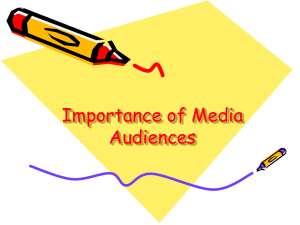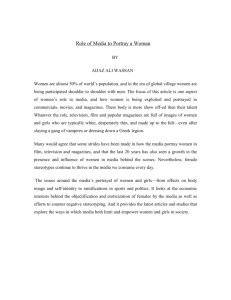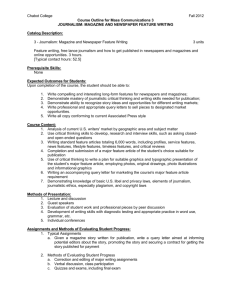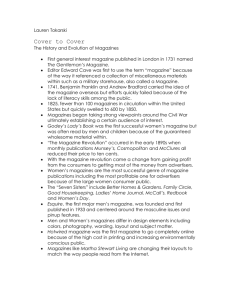Abrahamson - AEJMC Magazine Division
advertisement
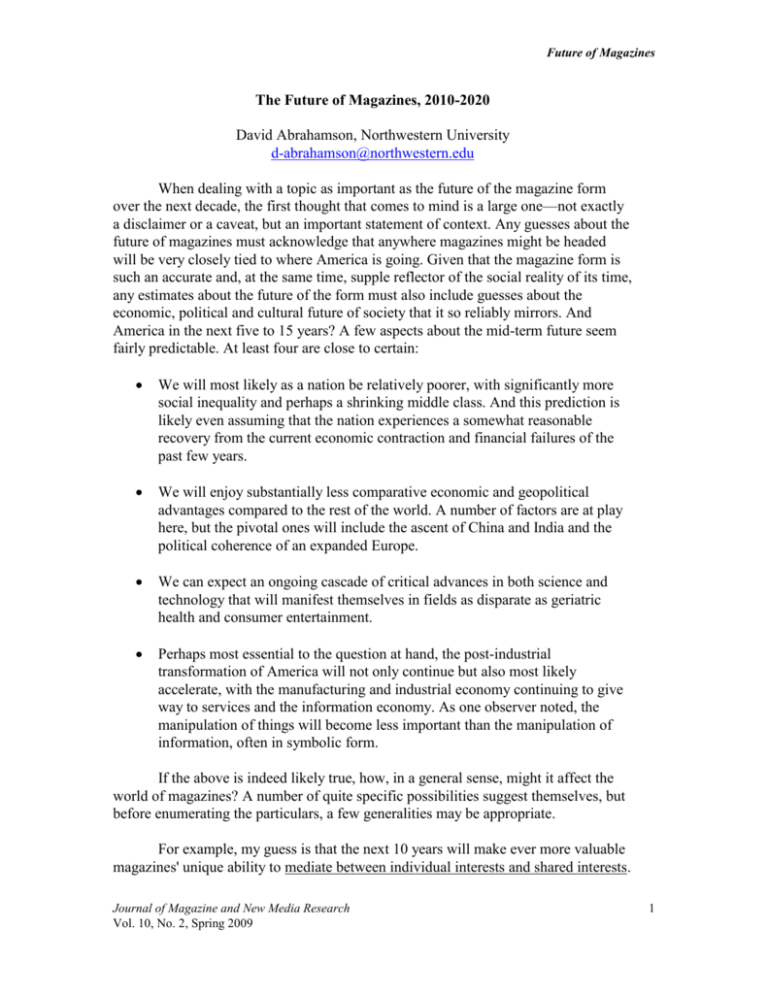
Future of Magazines The Future of Magazines, 2010-2020 David Abrahamson, Northwestern University d-abrahamson@northwestern.edu When dealing with a topic as important as the future of the magazine form over the next decade, the first thought that comes to mind is a large one—not exactly a disclaimer or a caveat, but an important statement of context. Any guesses about the future of magazines must acknowledge that anywhere magazines might be headed will be very closely tied to where America is going. Given that the magazine form is such an accurate and, at the same time, supple reflector of the social reality of its time, any estimates about the future of the form must also include guesses about the economic, political and cultural future of society that it so reliably mirrors. And America in the next five to 15 years? A few aspects about the mid-term future seem fairly predictable. At least four are close to certain: We will most likely as a nation be relatively poorer, with significantly more social inequality and perhaps a shrinking middle class. And this prediction is likely even assuming that the nation experiences a somewhat reasonable recovery from the current economic contraction and financial failures of the past few years. We will enjoy substantially less comparative economic and geopolitical advantages compared to the rest of the world. A number of factors are at play here, but the pivotal ones will include the ascent of China and India and the political coherence of an expanded Europe. We can expect an ongoing cascade of critical advances in both science and technology that will manifest themselves in fields as disparate as geriatric health and consumer entertainment. Perhaps most essential to the question at hand, the post-industrial transformation of America will not only continue but also most likely accelerate, with the manufacturing and industrial economy continuing to give way to services and the information economy. As one observer noted, the manipulation of things will become less important than the manipulation of information, often in symbolic form. If the above is indeed likely true, how, in a general sense, might it affect the world of magazines? A number of quite specific possibilities suggest themselves, but before enumerating the particulars, a few generalities may be appropriate. For example, my guess is that the next 10 years will make ever more valuable magazines' unique ability to mediate between individual interests and shared interests. Journal of Magazine and New Media Research Vol. 10, No. 2, Spring 2009 1 Future of Magazines As the national culture continues the fractionization begun in the midtwentieth century, the move to more niche-oriented, targeted, special-interest media will continue. But within that phenomenon, the power of magazines to define and then create the idea of community will become more crucial. This inextricable link between magazines and specific communities of interest will prove paramount in magazines' success. In sum, I suspect that the magazine form will have an opportunity to prosper, if only because over the next decade it may become ever more valuable to those people who are looking for voices that speak the truth to them about the things that they believe matter. With my preamble concluded, now to the specifics. Eight aspects about the future of the magazine industry over the mid-term future may be worthy to note: 1. The Internet will have a profound effect, but it will not displace print. Bill Gates not long ago offered an interesting observation about the difference between advertising and promotion. His point that print is so well-suited to advertising while the Web seemed best for promotion is probably true. Moreover, the print version of a magazine product will remain essential to the creation of "brand identity," something for which at least to date the Web does seems not terribly well suited. 2. The "narrow-casting" of all media, including magazines, will continue, perhaps even accelerate. As a result, most general-interest magazines without a solidly defined cultural niche will probably no longer be published. Part of this process of specialization will include the expansion of the role of magazines in the realm of analysis and interpretation—in the argot of its brethren genre of print journalism, newspapers: less news, more features. In a related trend, the web presence of magazines will change. Beyond the archival function, many of the large multi-title consumer magazine companies may redefine their on-line efforts to become more like portals. 3. Similarly, with the separation of function between the print and the Web efforts for most magazines, the on-line product will be viewed as a separate business and a distinct profit center based on new business models. This may be at odds with the currently fashionable concept of convergence, but it is likely to prove to be the case in many instances. 4. In the world of print, it is possible that a major transformation in the area of circulation will occur. Foreseeable changes in advertising practices and distribution expenses may lead many publishers to revisit their traditional circulation models. The net result will be that readers will be asked to pay a significantly greater share of the cost of magazines. Publishers will no longer Journal of Magazine and New Media Research Vol. 10, No. 2, Spring 2009 2 Future of Magazines need to artificially inflate their circulations to reach artificial rate bases, and there will be more individual titles with smaller circulations (see No. 2 above). 5. Despite all the claims of television and competing visual media such as podcasting, there may very well be an increase over the next decade or two in what social scientists call “ludenic” reading, i.e., reading for pleasure. If so, there may be a substantial growth in text-heavy—or perhaps even literary— publications that are read for largely avocational purposes. If true, this would also involve an enlarged appetite for the kinds of long-form journalism often found in lifestyle, travel, arts and leisure-active magazines (see also No. 2 above). 6. The specialized business press will become very adept at employing the Web, adapting to the strengths of the Internet to better serve their readers. In effect, there is an undeniable degree of genuine utility to reading a trade magazine at a computer screen at one's desk at work. In contrast one can make no such argument for most consumer magazines. 7. Another component of the magazine universe will certainly change in the next few years. The conventional role of the newsmagazine as a weekly digest of fact-based information will diminish. One of the major newsweeklies has abandoned the category, converting itself to a monthly. And programs are already underway at two of the other national newsweeklies to move most of the "hard news" out of the print product and on to the Web. In turn, there will be little or no "soft" feature content on the Web, while the print product will contain the longer, more analytic or interpretive pieces. 8. Finally, a brief nod to the important aspects that will probably remain the same. Though the world may be quite a different place 10 years from now, I can see no reason to expect that the magazine industry will cease to place a premium on those qualities which high-value magazine journalism has long held dear: rigorous and enterprising reporting; thoughtful and well-rounded conceptual analysis; compelling, eloquent and informative writing; and engaging and beautiful art direction. In closing with this last item immediately above, I confess that I am predicting something that might be cause for modest celebration. I dearly hope to be able to report to you a decade from now that some things that are terribly important—those aspects that make magazine journalism genuinely valued—have not changed. Journal of Magazine and New Media Research Vol. 10, No. 2, Spring 2009 3



